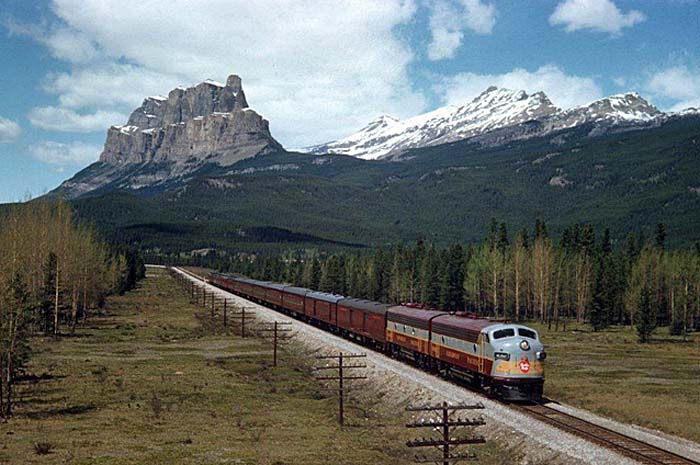
of Trains in the Rockies
Banff Alberta - From the point of view of a six-year-old who views the station as a playground, to an adolescent who receives from it a
paycheck, to an adult who looks back on it amicably as a way of life, Terry Gainer writes passionately about the Banff train station in his new book "When
Trains Ruled the Rockies: My Life at the Banff Railway Station".
Spending a large portion of his childhood raised on the tracks, Gainer has spent much of his life exploring the train station that remains at the bottom of
Lynx Street in the town's commercial center.
"The Canadian Pacific Railway (CP) station in Banff was the first home that I ever had that I vividly remember," he said.
"We arrived in Banff in 1948 and my dad was the station agent. Part of that position involved a residence on top of the station. I was six-years-old at
the time so all of my childhood memories are very vivid about the station, it was my home, it was my playground, across the tracks was the station bush and
that was like a kid's Disneyland."
It only seems suiting that someone with such a strong connection to the station would want to explore its history, pinpointing how integral the building once
was to the entire community.
"It was the center, it was the hub of the entire community, everything that happened in Banff including foodstuffs, people arriving, merchandise,
everything that came into Banff went through that station," he said.
"It was the economic hub of Banff, and the social hub, it was everything."
Gainer initially wasn't expecting to write this tale, but in 2014, when talks of renovations to the station began floating around, he started to feel there was
a story that needed to be told.
"I was talking to my daughter and I said, you know, it's kind of nice what they're doing there, but it's kind of tragic that there's no
story."
And she says, "Well why don't you write it? You lived there, you worked there, you were there for 14 years. I thought well what do I know about
writing? Which frankly was nothing."
The station was declared as a heritage site in 1991 by the federal government.
Built in 1910, the station is considered as "directly linked to the development of Canada's national park system and the evolution of Canada's tourist
industry," according to Canada's Historic Places website.
For Gainer, the urge to tell a story of a place that was an essential part of, not only his own life, but of the life of a town that once depended heavily on
the rail line that intersects it, became paramount.
"I chose those years, when I was there from 1948 to 1962 because, well, it's a historical memoir, I couldn't speak for anything before I was there, so I
chose that particular time frame. And that coincided with the heyday of rail travel to Banff," he said.
Gainer spent a week reading old archived newspapers from the Crag and Canyon, the only newspaper around at the time, as well as using the Whyte Museum
archives.
He found old photographs, read every article he could, and also collaborated with his older siblings who he said would have clearer memories of the earlier
days.
Aside from experiencing the station as a child, Gainer also worked there as a teenager.
"Then for the last few years that I worked there, through 1962 which was also the year of the Seattle World's Fair, and the biggest year of train travel
to Banff, but also the end of it, when it started to decline was after that, I was a red cap and that was the plum job at the Banff station because it was big
tips."
Red caps, Gainer said, would help arriving passengers with their baggage and usually would receive "huge tips" for doing so.
In fact, there are a few chapters in the book on the position, which Gainer said his older brother did before him.
While the book focuses on a time in Banff's history where trains literally ruled, it also represents a time in history when things were rapidly changing for
Canadian travel.
Gainer was there when the rails flourished, but also watched as it declined.
"In 1962, there was four trains west and four trains east every single day," he said.
"By 1966, it was down to two, two east and two west. By 1967 it was one east and one west. And the Canadian, it was called, continued to run until 1990,
at which time it was cancelled, but the Rocky Mountaineer then began to come into Banff, which was a summer train only."
Much of the latter isn't included in the time frame of Gainers book, as he writes only about the station while he knew it the best, during the time he lived
and worked there, but the effects of the withering service weren't wasted on him.
"I used to wander around there almost at will and visit with the operators and the telephone operators and it was sort of my backyard. It was probably a
heartbreaker for a lot of people."
At the end of it all, Gainer wrote the book as a personal venture with profit far from his mind, and ultimately, he's glad he did it and that Rocky Mountain
Books chose to publish it.
"It was a real sense of accomplishment, I never considered as starting a new career, and this wasn't done as a commercial venture," he
said.
"I was just hopeful that it would be published and put on some library shelf somewhere. And it's become a reality, which is kind of
neat."
Coming up on 21 Jun 2019 Gainer will have his first official book launch.
It will be hosted at the station itself at 11:00 in Banff.
Alternatively, a second launch will be held at the Whyte Museum on 11 Jul 2019 at 19:00.
To purchase "When Trains Ruled the Rockies: My Life at the Banff Railway Station", visit
rmBooks.com.
Alana MacLeod.
provisions in Section 29 of the Canadian
Copyright Modernization Act.


